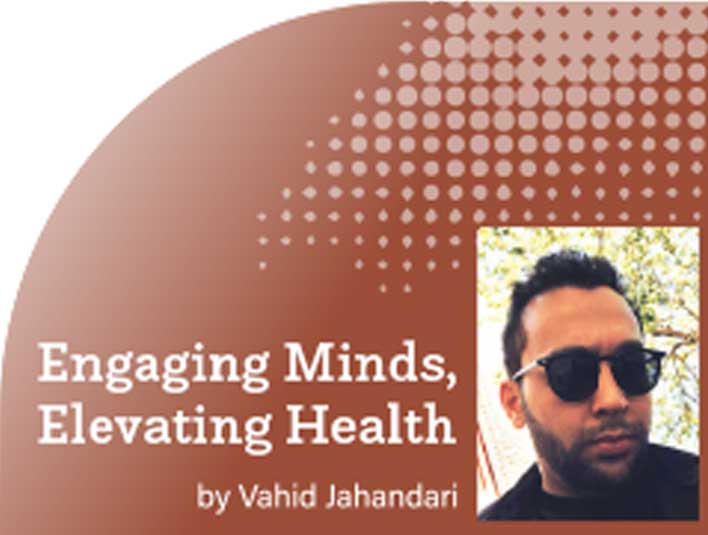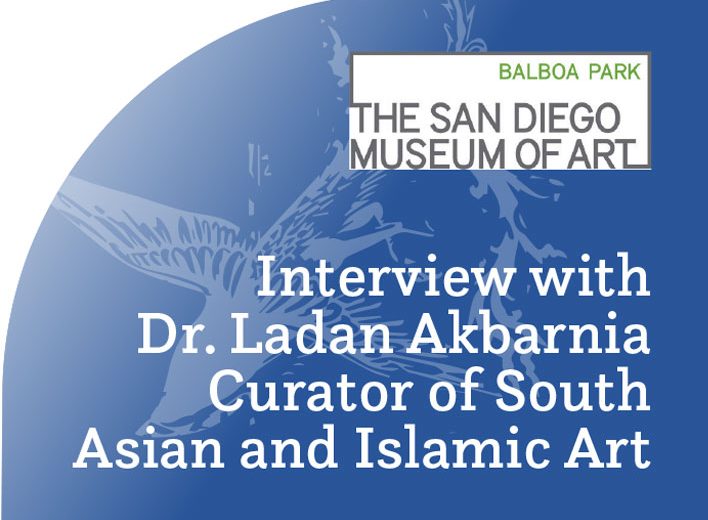Engaging Minds, Elevating Health: Improving Communication and Well-Being Through Music
By Vahid Jahandari
Communication is the key to understanding and connecting with one another. While we often think of language as the primary means of communication, there is another powerful way we connect with each other. Music and language share similarities, and they activate similar regions in the brain, signifying their interconnectedness. In this article, I explore music’s ability to bring people together, generate a wide range of emotions, and improve health.

Interaction And Communication Through Music-Making
Throughout history, music has served as a form of communication in various cultures—it has always been a way for humans to express emotions and establish connections with each other, transcending linguistic barriers. Therefore, music is more than just entertainment; it plays a crucial role in establishing cultural identity and facilitating cross-cultural communication. Moreover, music has the power to unlock long-buried memories, evoke an intricate tapestry of emotions, forge connections with one another, and shape our narratives.
When musicians come together to play music, they engage in a form of communication known as joint action. Unlike regular conversation, which involves turn-taking and mirroring of body movements, musical interactions require precise coordination among performers to create a harmonious and coherent performance. Musicians must breathe together, align note onsets, and synchronize movements to maintain a steady tempo to ensure a successful outcome. The coordination extends to intonation, involving adjustments and relying on deep listening and constant matching at multi-disciplinary levels. This level of coordination involves mutual entrainment, where musicians adapt to each other’s changes in rhythm, harmony, and emotions. Recent neuroimaging studies have examined brain activity during musical interactions, revealing neural synchronization between performers. (1) Further exploration of interpersonal bodily coupling in naturalistic musical contexts will shed light on the underlying mechanisms that support cohesive performances. Future studies should embrace the dynamic nature of musical communication by studying different interpersonal coupling during joint music-making.
There is a large spectrum of musical engagement that exists in different individuals and cultures. The extent of musical engagement varies widely among populations and groups of people within a society. This variability affects how music is used for social bonding and everyday communication. Exploring the differences in musical and verbal communication between musicians accustomed to playing together versus strangers can shed light on the neural overlap between these two forms of communication—language (or words) vs. music.
Music serves as a model for studying human communication due to its universality and emotional impact. By delving into the dynamics of joint music-making and exploring the intricate ways emotions are communicated through music, we can gain insights into human communication processes. While prior research has touched upon aspects of musical communication, such as the relationship between music and language processing, these studies have limitations in fully encapsulating the essence of genuine musical interactions. Music is an art that needs precise coordination among performers, including timing, tuning, and how they follow each other.
Emotional Sharing while Music-Making
The interplay among music, the mind, and the body exemplifies the impact music can have on mind and well-being. Interestingly, “song” is revealed to be more effective than speech at modulating emotion in infants. Studies have shown exceptionally talented musicians are able to mentally reproduce any piece of music in their headspace in real-time, activating the brain cells that process and receive vibrational frequencies. (2) These resonances or ‘acoustic oscillations,’ whether emanating from a live symphonic opera performance or in-ear electronic music, maintain certain weights as unchained particles. The audibility of these frequencies is through the vibrational energy of the source, which directly influences our emotions, eliciting upliftment, grief, or other emotional responses.
Emotions play a significant role in creating a cohesive social unit among people engaged in musical interactions. Current studies employ behavioral methods and questionnaires to assess emotional states before and after music-making. (3) Additionally, researchers ask performers and listeners to continuously indicate their emotional states throughout a performance. Advanced neuroimaging techniques can decode the fine-grained patterns of brain responses associated with changing emotional states during music-making.
Understanding how emotions are communicated and shared during music-making can tell us how music brings people together emotionally. To understand musical communication, researchers use natural and real-life musical situations in their studies. This way, they can see the complex dynamics that happen when people make music together. By observing how performers adapt and respond to each other in real-time, we can learn more about how musical communication works. This will help connect what we find in the lab with how music is experienced in the real world. Comparing highly trained musicians with less trained individuals or those from different cultural backgrounds demonstrate the many ways musical communication can happen. In exploring the parallels between music and language, it becomes evident that music is a multisensory experience. Music offers a unique lens to study certain communication aspects often overlooked in language research.
In various contexts, music establishes shared cultural identity and plays a central role in rituals like weddings, funerals, and festivals, owing to its emotional communicative power. In film, music adds emotional depth to critical plot points, and in therapeutic settings, it triggers autobiographical memories in patients with dementia. This ability to convey emotional content sets music apart from speech and fosters powerful social–emotional connections among people. While some studies have investigated music’s impact on individual listeners’ emotional processing, there has not been an exploration on how the brain represents the moment-to-moment dynamics of musical emotion.
The Therapeutic Potential of Music
When musicians play together, they experience a bonding effect. Additionally, music has the power to trigger various physiological responses, such as chills and changes in heart rate. These responses can be amplified depending on the weather and environmental temperature in which the individual is exposed to the sounds.
Music can also evoke a psychological state of mind that transcends ordinary cognitive perception. This heightened state of consciousness can be deliberately induced through the use of psychoactive drugs like MDMA (commonly known as ecstasy). Individuals may channel the “sound energy” absorbed from the space’s emanations and direct it to their anatomy for treating physical ailments or psychic blocks within their nervous system, or to address physical ailments or psychological barriers. These blocks may have accumulated due to stress, fear, and other psychological factors that negatively impact human cognition. In this context, the role of “set and setting” assumes paramount importance—each can significantly influence an individual’s interpretation of music. “Set” refers to the individual’s mindset, emotional state, and psychological factors, while “setting” encompasses the environment and social context in which the music is experienced.
The potential use of psychoactive substances to enhance the music-listening experience in order to facilitate a therapeutic session may raise ethical concerns. The recreational use of these substances can have unpredictable effects, leading to potential risks. It is essential to emphasize that using psychoactive drugs in a therapeutic setting should be done under the guidance of trained professionals in a controlled and safe environment. Therefore, the topics discussed are solely intended for informational purposes and should not be construed as advocating for their use in any context, including music therapy or otherwise. Music engagement can improve communication and social engagement without resorting to the use of psychoactive substances.
In the realm of clinical applications, music therapy stands out as a powerful tool for improving communication among those who struggle with verbal expression and social engagement. Beyond its artistic and social importance, music can be a powerful tool in therapy. Music therapy has shown promise in helping people with communication difficulties, like autism spectrum disorder or dementia. By studying how music therapy affects the brain, we can create better therapies to improve how people connect and communicate with each other. For instance, music therapy has shown positive effects in improving communication in children with autism spectrum disorder (ASD) and individuals with dementia. More research is needed to fully comprehend the cognitive, behavioral, and social benefits of music therapy and the underlying neural mechanisms responsible for these improvements.
Music-Based Interventions in Education
Numerous studies have highlighted the relationship between music and well-being in various contexts. (4) Music has been found to enhance confidence, relaxation, and stress relief. It also fosters a sense of accomplishment. The concept of well-being can be complex, encompassing various dimensions such as positive emotions and life satisfaction. One popular study identifies four key elements of well-being: Positive Emotion, Relationships, Meaning, and Accomplishment. (5) In educational settings, well-being is promoted through various interventions, including social emotional learning.
In recent years, there has been growing concern about the mental health and well-being of children and young adults. The decline in children’s enjoyment of school has been accompanied by an alarming increase in the rates of depression among young people. There is a pressing need for strategies to improve children’s well-being from an early age, particularly in school settings.
One emerging field of research—relatively new, but promising—explores the potential impact of music-based interventions, such as group singing, on children’s well-being. Studies have shown that participation in singing can lead to improved physical health, psychological well-being, and overall quality of life in children. (6) Moreover, the benefits of group singing are amplified when led by music specialists who can effectively create an engaging experience for children.
The concept of “flow” refers to a psychological state in which individuals become completely absorbed in an activity. Flow occurs when there is a balance between the challenge of a task and the individual’s skills, resulting in a highly engaged state. Music, including group singing, has been linked to the induction of flow, leading to enhanced creativity, motivation, and overall well-being. Children from economically disadvantaged backgrounds often face lower levels of subjective well-being and academic/career achievement. Given the potential benefits of group singing on well-being and the need to address the well-being of disadvantaged children, one study indicated a significant improvement in children’s subjective well-being following a group singing method intervention. (7) The children expressed enjoyment and a sense of accomplishment from participating in the intervention, aligning with the concept of flow. The flow state—characterized by all-embracing absorption—was observed in the children during the singing sessions.
Group singing can serve as a valuable tool to enhance subjective well-being, foster social connectedness, and provide engaging activities for all. The positive impact of singing on disadvantaged children highlights the potential of music-based interventions to address well-being disparities among different populations.
1- This refers to the periodic back-and-forth motion of air molecules that create sound waves in response to the source of sound, such as musical instruments or speakers, within a given environment.
__________________________________________________________
References
(1) Carlson, E., et al. “Maladaptive and Adaptive Emotion Regulation Through Music: A Behavioral and Neuroimaging Study of Males and Females,” Frontiers in Human Neuroscience (August 26, 2015).
(2) Woody, R.H. “Musicians’ Use of Harmonic Cognitive Strategies When Playing by Ear,” Psychology of Music ( Sept. 2020).
(3) Hallam, S., and Creech, A. “Can Active Music Making Promote Health and Well-Being in Older Citizens? Findings of the Music for Life Project.” London Journal of Primary Care, Vol. 8, No. 2 (2016), pp. 21–25.
(4) Batt-Rawden, K.B. and Stedje, K. “Singing as a health-promoting activity in elderly care: a qualitative, longitudinal study in Norway.” Journal of Research in Nursing, 25(5) (2020), pp. 404–418.
(5) Croom, Adam M. “Music Practice and Participation for Psychological Well-Being: A Review of How Music Influences Positive Emotion, Engagement, Relationships, Meaning, and Accomplishment.” Musicae Scientiae, Vol. 19, No. 1 (2015), pp. 44–64.
(6) Hinshaw, T., et al. “Group Singing and Young People’s Psychological Well-Being.” The International Journal of Mental Health Promotion, Vol. 17, No. 1 (2015), pp. 46–63.
(7) Fancourt, D., et al. “Psychosocial Singing Interventions for the Mental Health and Well-Being of Family Carers of Patients with Cancer: Results from a Longitudinal Controlled Study.” BMJ Open, Vol. 9, No. 8 (2019).


















